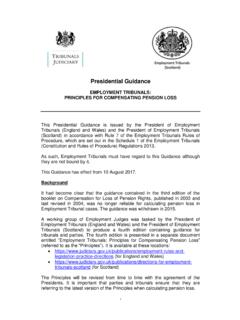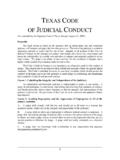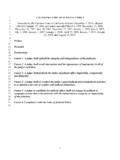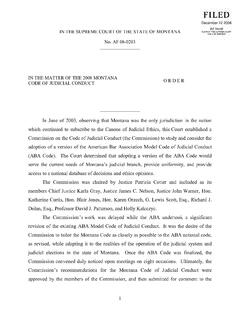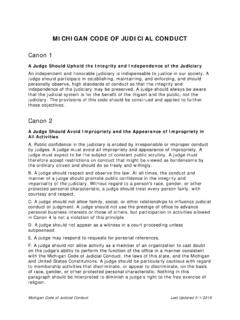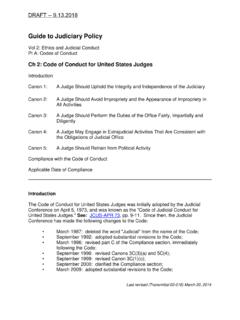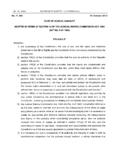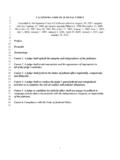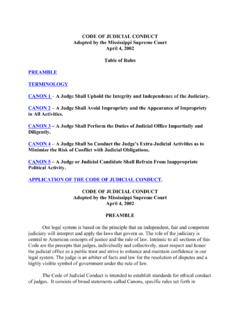Transcription of Guide to Judicial Conduct March 2013
1 Guide to Judicial ConductMarch 2013 Guide to Judicial Conduct 20132 Acknowledgments 4 Standing Committee on Guide to Judicial Conduct 5 Chapter one: Introduction 7 Chapter two: Judicial independence 9 Chapter three: Impartiality 10 Chapter four: Integrity 13 Chapter five: Propriety 15 Chapter six: Competence and diligence 18 Chapter seven: Personal relationships and perceived bias 19 Chapter eight: Activities outside court 21 Chapter nine: After retirement 29 The Office for Judicial Complaints 30 Appendix 1.
2 Dignity at Work statement 31 Appendix 2: A brief Guide to the Equality Act 2010 33 Appendix 3: Letter to all judiciary 36 Appendix 4: Blogging by Judicial office-holders 38 Appendix 5: Amendments 39 ContentsContentsGuide to Judicial Conduct 20133 This Guide to Judicial Conduct has been drafted by a working group of judges set up by the Judges Council, under the chairmanship of Lord Justice Pill and published by the Judges Council following extensive consultation with the judiciary. As Chairman of the Judges Council I would like to express my gratitude to the working group for their immense generosity in time and effort in producing the Guide .
3 We are justifiably proud of our existing standards of Judicial Conduct . However, the recent adoption of written codes of Conduct throughout the world and the endorsement of principles by the UN Human Rights Commission at Geneva in April 2003, have indicated that a written Guide for England and Wales would now be desirable and in accord with international practice. The range of restraints that are inherent in the acceptance of Judicial office together with the obligations placed on judges by the taking of the Judicial Oath, have been taken into account by the working group. However, the responsibilities and the public s perception of the standards to which judges should adhere are continuously evolving. To take but one example, when I came to the Bar it was considered in order for a son to appear before his father.
4 This would be unacceptable today. So this Guide will have to evolve to keep up with these changes. This Guide is intended to offer assistance to judges on issues rather than to prescribe a detailed code and to set up principles from which judges can make their own decisions and so maintain their Judicial independence. I know that it will prove to be a valuable tool in assisting judges to deal with difficult ethical problems with which they will be inevitably faced. As important requirements as to Conduct are also set out in each member of the judiciary s Terms and Conditions of Appointment, the Guide must be read in conjunction with those Terms and Conditions. Although it is primarily aimed at professional full and part time judges, I would hope that the Guide will be of assistance to all the judiciary, including lay magistrates and tribunal members as Rt.
5 Hon. The Lord Judge, Lord Chief Justice of England and Wales Chairman of the Judges CouncilForewordForewordGuide to Judicial Conduct 20134In November 2002 a copy of the paper Guidelines to Judicial Ethics drafted under the auspices of the Judicial Studies Board by a committee chaired by Dame Janet Smith was placed before the Judges Council. The assistance derived from this paper is gratefully acknowledged. The Judges Council agreed that a working group should be set up and invited Lord Justice Pill to chair it and to select its members, which he did in consultation with Lord Justice Judge, then Senior Presiding Judge. The members were Mr Justice Gage, Mr Justice McCombe, His Honour Judge Brodrick, Her Honour Judge Eleri Rees and District Judge Michael Walker.
6 The generous time given and invaluable advice received from the working group is gratefully acknowledged. Consultation on a draft Guide was subsequently carried out with the Court of Appeal and High Court Benches, the Circuit and District Benches via their respective Council and Association and the comments were collated. Following that consultation the final draft was shown to the Lord Chancellor and he was invited to make any further comments. The generous assistance given by the Secretary to the Council for Her Majesty s Circuit Judges and by the Secretary of the Association of District Judges is gratefully acknowledged together with the assistance given by the Secretary to the Judges Council, the staff of the Office of the Lord Chief Justice and officials of the DCA and the Court Service throughout the preparation and publication of this Guide .
7 Grateful thanks are given to all those judges who responded to the consultation and to the Lord Chancellor for his support. Of the Guides from other jurisdictions to which reference has been made in the Introduction to this Guide , acknowledgement is particularly due to the Australian Chief Justices document Guide to Judicial Conduct , the form and content of which have been a valuable model. AcknowledgmentsAcknowledgmentsGuide to Judicial Conduct 20135 Standing CommitteeStanding Committee on Guide to Judicial ConductFollowing the publication of this Guide in October 2004, the Judges Council has set up a Standing Committee to keep the Guide under review and to deal with any points of principle that may not be dealt with in the Guide or that may need revision.
8 The members of the Standing Committee are: Lord Justice Patten (chairman) Mrs Justice Macur DBE Her Honour Judge Elisabeth Fisher District Judge Tim Jenkins District Judge Michael Walker CBE Designated Immigration Judge Paul Shaerf, as representing tribunals Senior District Judge Riddle, Chief Magistrate Andr Rebello OBE, HM Coroner John Fassenfelt JP, Chairman of the Magistrates appears from its contents, the Guide is intended to offer assistance to judges about their Conduct and to set out principles on the basis of which judges can make their own decisions. Consultation with colleagues and with the head of the appropriate jurisdiction, as defined in paragraph of the Guide (which in the case of tribunal members includes their Chamber or Tribunal President), is encouraged.
9 That is also encouraged by the Standing Committee, the existence and functioning of which is not designed or intended to cut across or interfere with existing collegiate arrangements. It is certainly not intended that particular situations with which judges are confronted should routinely be referred to the Committee or one of its members. Where a point of general application or concern arises, however, whether addressed in the Guide or not, it may be appropriate to refer it to the Committee either by a reference to the Secretary of the Committee, who is also Secretary to the Judges Council, or to the Chairman, or a member of the Committee. The Committee plans to meet at least twice a year, and more frequently if the need should arise. At such meetings, the Committee will consider, from information available to members, how the Guide is working in practice.
10 It will clearly assist them in that task if judges do refer to the Committee Guide to Judicial Conduct 20136 Standing Committeeany points of general concern which have arisen. While it is hoped that changes to what are intended to be general principles guiding Conduct will not frequently be required, consideration may be given by the Committee to possible additions to and revisions of the contents of the Guide . It is understood that a need for change may be perceived by judges whether or not a specific problem has actually arisen. If that should arise, the Committee would be glad to be told. Committee members of course hope that the work of the Committee will assist judges in their task of maintaining high standards in the administration of justice.


